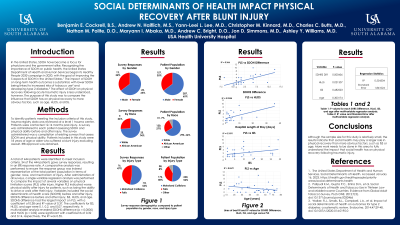Back

Trauma
Category: Quickshot Oral Session 22
Quickshot Oral : Quickshot Oral Session 22
SOCIAL DETERMINANTS OF HEALTH IMPACT PHYSICAL RECOVERY AFTER BLUNT INJURY
Tuesday, February 14, 2023
7:00am – 8:00am East Coast USA Time

- AW
Ashley Y. Williams, MD
Assistant Professor, Trauma Surgeon
University of South Alabama Medical Center, United States - BC
Benjamin Cockrell, BS
United States
Principal Contact(s)
Presenter(s)
Objectives: As defined by the Centers for Disease Control and Prevention (CDC), the Social Determinants of Health (SDOH) are conditions in the environment that affect function and outcomes. The SDOH are divided into the following categories: economic stability, education access and quality, health care access and quality, neighborhood and built environment, and social and community context. It is known that the SDOH can impact long-term health outcomes. What is less understood is the direct impact of social determinants on physical recovery after injury. Our objective was to conduct a study to fill this gap in knowledge. We hypothesized that poor SDOH would render worse physical recovery after blunt injury.
Methods: Trauma registry data was reviewed at a level 1 trauma center. Patients were contacted 12-14 months after injury. A survey was administered to each patient assessing SDOH and physical ability before and after injury. The survey administered was a compilation of existing surveys that assess SDOH and physical ability. Patients included in this study were 18 years of age or older who suffered blunt injury, excluding assault. IRB approval was obtained.
Results: A total of 444 patients were identified to meet inclusion criteria. 34 of the 444 patients gave survey responses, resulting in an 8% response rate. A comparative analysis was performed to ensure the response group was indeed representative of the total patient population in terms of gender, race, and mechanism of injury. After administration of all surveys, a single-variable regression analysis was performed to compare the impact of several variables on physical limitation scores (PLS) after injury. Variables included the social determinants health risk score (SDHRS) post-injury, SDHRS difference before and after injury, injury severity score (ISS), hospital length of stay (HLoS), and age. SDHRS difference had the largest impact on PLS, with a coefficient of 0.38 and R2 value of 0.37. The coefficients for ISS, HLoS, and age were 0.1, 0.2, and -0.04, respectively. The R2 values for the same variables were 0.11, 0.28, and 0.07, respectively. A multivariable analysis revealed SDHRS difference (p = 0.0005) and HLOS (p = 0.02) were significant with coefficients of 0.32 and 0.15, respectively. The R2 was 0.55.
Conclusion: This study indicates that social health may play a larger role in physical recovery than more obvious factors, such as ISS or age. Additional investigations should be conducted to fully understand the impact that social health has on physical recovery after blunt injury.
Methods: Trauma registry data was reviewed at a level 1 trauma center. Patients were contacted 12-14 months after injury. A survey was administered to each patient assessing SDOH and physical ability before and after injury. The survey administered was a compilation of existing surveys that assess SDOH and physical ability. Patients included in this study were 18 years of age or older who suffered blunt injury, excluding assault. IRB approval was obtained.
Results: A total of 444 patients were identified to meet inclusion criteria. 34 of the 444 patients gave survey responses, resulting in an 8% response rate. A comparative analysis was performed to ensure the response group was indeed representative of the total patient population in terms of gender, race, and mechanism of injury. After administration of all surveys, a single-variable regression analysis was performed to compare the impact of several variables on physical limitation scores (PLS) after injury. Variables included the social determinants health risk score (SDHRS) post-injury, SDHRS difference before and after injury, injury severity score (ISS), hospital length of stay (HLoS), and age. SDHRS difference had the largest impact on PLS, with a coefficient of 0.38 and R2 value of 0.37. The coefficients for ISS, HLoS, and age were 0.1, 0.2, and -0.04, respectively. The R2 values for the same variables were 0.11, 0.28, and 0.07, respectively. A multivariable analysis revealed SDHRS difference (p = 0.0005) and HLOS (p = 0.02) were significant with coefficients of 0.32 and 0.15, respectively. The R2 was 0.55.
Conclusion: This study indicates that social health may play a larger role in physical recovery than more obvious factors, such as ISS or age. Additional investigations should be conducted to fully understand the impact that social health has on physical recovery after blunt injury.

